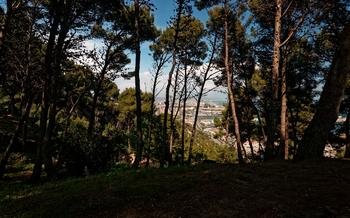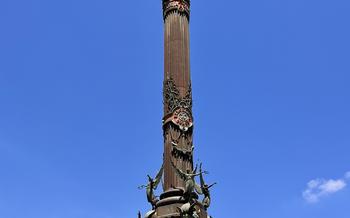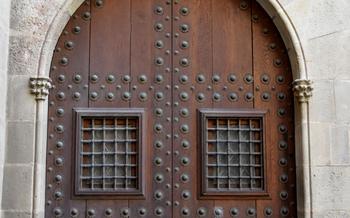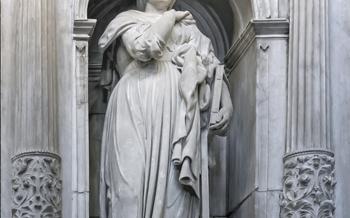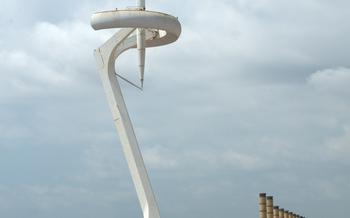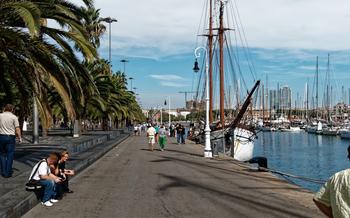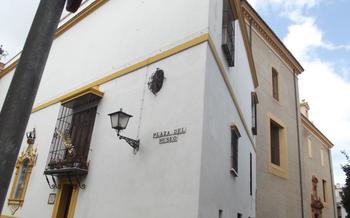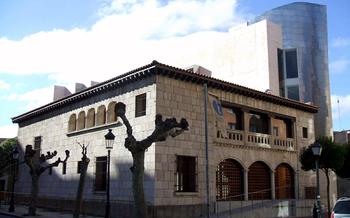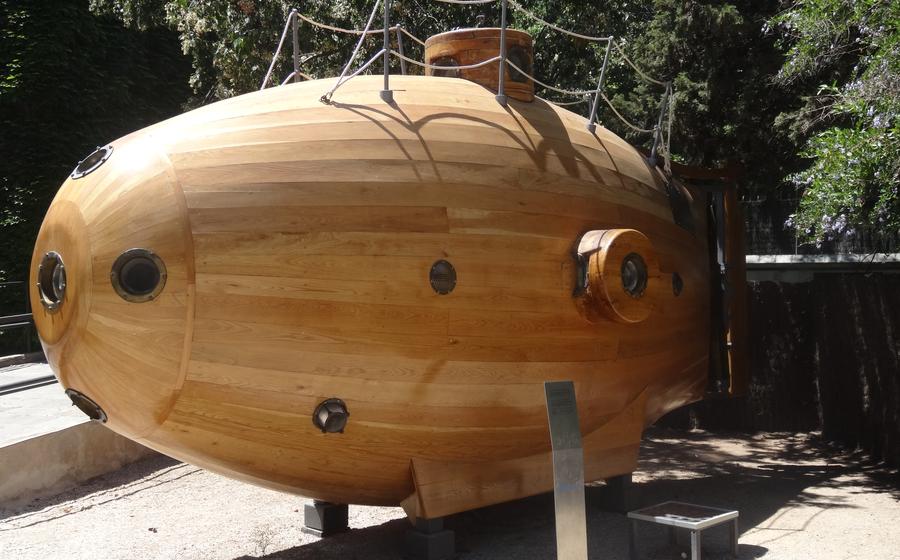
Museu Marítim Drassanes
- Unveiling the Drassanes Reials: A Legacy of Maritime Excellence
- A Glimpse into the Past: The Maritime Museum's Galleries
- Through the Eyes of a Shipwright: The Drassanes Reials Workshop
- Stories from the Sea: The Maritime Museum's Archives
- The Art of Navigation: The Museu Marítim's Cartography Collection
- Barcelona's Maritime Heritage: A Walk Through the Old Port
- The Maritime Museum's Library: A Treasure Trove of Knowledge
- Maritime Festivals and Events: Embracing the Seafaring Spirit
- The Port of Barcelona: A Thriving Maritime Hub
- Barcelona's Beaches: A Haven for Sea Lovers
- The Barceloneta Neighborhood: A Maritime Charm
Unveiling the Drassanes Reials: A Legacy of Maritime Excellence
The Drassanes Reials, also known as the Royal Shipyard, is a historic building that stands as a testament to Barcelona's rich maritime heritage. Constructed in the 13th century, the shipyard was a hub of shipbuilding activity, where skilled craftsmen meticulously crafted wooden vessels that would set sail to explore the world's oceans.
The architectural features of the Drassanes Reials are a testament to its historical significance. The building's Gothic arches, vaulted ceilings, and massive wooden beams create a sense of awe and grandeur. Visitors can wander through the shipyard's vast halls and workshops, where they can almost hear the hammers and saws of the shipwrights who once labored here.
The Drassanes Reials played a pivotal role in shaping Barcelona's maritime prowess. From the 13th to the 18th centuries, the shipyard was responsible for constructing warships, merchant vessels, and galleys that helped to establish Barcelona as a major maritime power. The city's strategic location on the Mediterranean Sea made it a natural gateway for trade and exploration, and the Drassanes Reials was instrumental in building the fleet that would carry Barcelona's influence far and wide.
A Glimpse into the Past: The Maritime Museum's Galleries
The Museu Marítim's galleries provide a captivating journey through the history of Barcelona's maritime heritage. Embark on an exploration of the diverse exhibits, each showcasing a different aspect of the city's seafaring past.
-
Model Ships: Marvel at the intricate details of model ships, from ancient galleys to modern warships. These miniature masterpieces offer a glimpse into the evolution of shipbuilding and maritime technology.
-
Maritime Tools and Equipment: Discover the tools and equipment used by sailors and shipbuilders throughout the centuries. From navigation instruments to fishing gear, these artifacts provide insights into the daily lives of those who worked on the sea.
-
Interactive Displays: Engage with interactive displays that bring history to life. Learn about the challenges of navigation, experience the thrill of a virtual boat race, or explore the depths of the ocean through immersive multimedia presentations.
-
Educational Programs: The museum offers a range of educational programs and workshops for visitors of all ages. Learn about maritime history, participate in hands-on activities, and uncover the secrets of the seafaring world.
Through the Eyes of a Shipwright: The Drassanes Reials Workshop
Step into the Drassanes Reials workshop and witness the magic of traditional shipbuilding come to life. This fascinating space offers a glimpse into the techniques and tools used by skilled shipwrights of the past. Watch as artisans demonstrate the meticulous process of constructing a wooden vessel, from shaping the hull planks to assembling the intricate rigging. Learn about the various types of wood used in shipbuilding and the significance of each component in the overall structure of the vessel.
The workshop is a testament to the artistry and expertise of the shipwrights who once worked at the Drassanes Reials. It provides a unique opportunity to appreciate the craftsmanship that went into building the ships that sailed the seas and shaped Barcelona's maritime history. As you observe the shipwrights at work, you'll gain a deeper understanding of the challenges and complexities involved in constructing a seaworthy vessel.
Take a moment to admire the tools used by the shipwrights, many of which have been passed down through generations. These tools, ranging from simple hand tools to specialized equipment, played a crucial role in shaping the wooden hulls and masts of the ships. The workshop also showcases various types of wood, each chosen for its specific properties and suitability for different parts of the vessel.
The Drassanes Reials workshop is a living museum that brings the past to life. It offers visitors a chance to experience the vibrant maritime culture of Barcelona and to appreciate the skill and dedication of the shipwrights who built the city's impressive fleet of ships.
Stories from the Sea: The Maritime Museum's Archives
The Maritime Museum's archives house a wealth of maritime documents, maps, and manuscripts that offer a glimpse into the rich history of Spanish maritime exploration and trade. These records, which date back centuries, provide invaluable insights into the lives and experiences of sailors, merchants, and explorers of the past.
Among the highlights of the collection are the ship logs of Christopher Columbus, which detail his epic voyages across the Atlantic Ocean. These firsthand accounts offer a fascinating perspective on the challenges and triumphs of early exploration, as well as the impact of European colonialism on the Americas.
Other notable documents include the portolan charts of the 14th and 15th centuries, which were used by sailors to navigate the Mediterranean Sea. These beautifully drawn maps, with their intricate coastlines and decorative elements, are not only historical artifacts but also works of art.
Through these documents, visitors to the Maritime Museum can learn about the maritime explorations that shaped the world we live in today. They can trace the routes of famous explorers, discover the stories of forgotten sailors, and gain a deeper understanding of the role that the sea has played in human history.
The Art of Navigation: The Museu Marítim's Cartography Collection
The Museu Marítim in Barcelona boasts an impressive collection of antique maps and charts that chronicle the evolution of cartography and its profound impact on maritime exploration. These rare and valuable documents offer a glimpse into the minds of early navigators and the challenges they faced as they ventured into uncharted waters.
One of the highlights of the collection is the Catalan Atlas, a masterpiece created in 1375 by the Majorcan cartographer Abraham Cresques. This beautifully illustrated atlas features detailed maps of the Mediterranean Sea and the Black Sea, along with fanciful depictions of mythical creatures and distant lands.
Another notable exhibit is the Portolan chart, a type of navigational map that was widely used by sailors in the Middle Ages. These charts were drawn on vellum or parchment and featured detailed coastlines, compass roses, and rhumb lines. They provided sailors with essential information about distances, directions, and potential hazards along their routes.
The museum's cartography collection also includes a variety of globes, celestial charts, and nautical instruments. These artifacts demonstrate the ingenuity and skill of early cartographers and navigators, who relied on a combination of observation, experimentation, and mathematical calculations to create accurate maps and charts.
By studying the maps and charts in the Museu Marítim's collection, visitors can gain a deeper understanding of the history of navigation and the role it played in shaping the course of maritime exploration. These documents provide a tangible link to the past and offer a glimpse into the minds of the intrepid sailors who set out to conquer the vast oceans.
Barcelona's Maritime Heritage: A Walk Through the Old Port
Barcelona's old port area, known as the Port Vell, is a treasure trove of maritime heritage. A stroll through this atmospheric neighborhood reveals a fascinating tapestry of history, architecture, and maritime traditions.
The old port played a crucial role in Barcelona's development as a major maritime power. In the Middle Ages, it was a bustling hub of trade and commerce, with ships from all over the Mediterranean Sea docking at its quays. The port also served as a base for the city's powerful navy, which played a key role in the defense of the Catalan coast.
Today, the old port is a vibrant mix of old and new. Historic buildings, such as the Llotja de Mar (the former maritime exchange) and the Drassanes Reials (the old shipyards), stand alongside modern developments, such as the Maremagnum shopping center and the W Hotel.
A walk through the old port is a must-do for anyone interested in Barcelona's maritime heritage. Visitors can explore the narrow cobbled streets, admire the beautiful architecture, and soak up the lively atmosphere. There are also plenty of opportunities to learn about the city's maritime past, with guided tours, museums, and exhibitions available.
One of the highlights of the old port is the Museu Marítim de Barcelona. This world-class museum is dedicated to the history of maritime navigation and trade. Its exhibits include model ships, antique maps, and maritime tools, as well as a replica of a medieval galley.
Another popular attraction is the Drassanes Reials, the old shipyards where Barcelona's galleys were built and repaired. Today, the Drassanes Reials houses a museum that tells the story of the city's shipbuilding industry.
For a taste of the old port's vibrant atmosphere, visitors should head to the Barceloneta Market. This lively market is a great place to sample fresh seafood and other local delicacies.
Barcelona's old port is a fascinating place that offers something for everyone. Whether you're interested in history, architecture, or simply soaking up the atmosphere, a walk through this charming neighborhood is a must-do for any visitor to Barcelona.
The Maritime Museum's Library: A Treasure Trove of Knowledge
Enrich your maritime knowledge at the Museu Marítim's extensive library, a haven for maritime enthusiasts and researchers. Delve into a vast collection of books, journals, manuscripts, and documents, covering every aspect of maritime history, culture, and exploration. The library's rare and valuable collection includes ancient texts, first-hand accounts of seafaring voyages, and detailed charts and maps. Immerse yourself in the wisdom of the past as you uncover the stories of legendary explorers, brave sailors, and innovative shipbuilders. Whether you're a seasoned maritime expert or simply curious about the sea's allure, the Museu Marítim's library promises an enriching and enlightening experience.
Maritime Festivals and Events: Embracing the Seafaring Spirit
Barcelona's maritime heritage is celebrated throughout the year with a variety of festivals and events that showcase the city's seafaring traditions and culture. These events offer a unique opportunity for visitors to immerse themselves in the local maritime culture and experience the vibrant atmosphere of Barcelona's waterfront.
One of the most popular maritime events is the Barcelona Boat Show, held annually in October. This international boat show attracts exhibitors from around the world and features a wide range of boats, from small sailing yachts to luxury motor yachts. Visitors can also enjoy live music, food stalls, and other entertainment.
Another highlight is the Barcelona International Maritime Festival, held every two years in September. This festival features a spectacular parade of sailing ships, traditional boats, and modern vessels, as well as exhibitions, workshops, and concerts. Visitors can also take part in sailing trips, boat races, and other water sports activities.
For those interested in learning more about Barcelona's maritime history, the Maritime Museum hosts a variety of events throughout the year, including lectures, workshops, and guided tours. These events offer a deeper insight into the city's seafaring past and its role in shaping Barcelona's identity.
Whether you're a sailing enthusiast, a history buff, or simply looking for a fun and festive way to experience Barcelona's maritime culture, be sure to check out the city's many maritime festivals and events. These events offer a unique opportunity to immerse yourself in the local culture and traditions, and to celebrate the city's rich maritime heritage.
The Port of Barcelona: A Thriving Maritime Hub
Barcelona's maritime heritage is not limited to its historic shipyard and museum. The city boasts a thriving modern port that serves as a vital economic hub and a gateway to the Mediterranean. Over the centuries, the Port of Barcelona has played a crucial role in the city's growth and prosperity, facilitating trade, boosting tourism, and connecting Barcelona to the world.
In the early 20th century, the port underwent significant expansion and modernization, becoming one of the most important ports in the Mediterranean region. Today, it is a bustling hub of activity, handling a vast volume of cargo and welcoming numerous cruise ships and ferries. The port's infrastructure is state-of-the-art, featuring modern terminals, warehouses, and logistics facilities.
The Port of Barcelona is not just a commercial center; it is also a vibrant and dynamic space that offers a range of attractions for visitors. The World Trade Center, located within the port area, is a hub for international business and trade. The port also features a cruise ship terminal, allowing visitors to embark on exciting Mediterranean cruises.
For those interested in maritime history, the port is home to several historic ships that are open to the public. Visitors can explore these vessels, learn about their past, and experience the thrill of stepping aboard a real-life sailing ship. Guided tours are available to provide insights into the history and operation of the port, allowing visitors to delve deeper into Barcelona's maritime legacy.
Whether you are a history buff, a maritime enthusiast, or simply looking for a unique experience, the Port of Barcelona is a must-visit destination. Its bustling atmosphere, historic charm, and modern facilities make it a fascinating place to explore and discover the essence of Barcelona's maritime heritage.
Barcelona's Beaches: A Haven for Sea Lovers
Barcelona is blessed with a stunning coastline and a variety of beautiful beaches that offer a range of activities and attractions for visitors. From the popular Barceloneta beach to the quieter beaches of the Maresme coast, there is something for everyone.
Barceloneta beach is the most popular and well-known beach in Barcelona. It is located in the heart of the city, just a short walk from the Gothic Quarter. Barceloneta is a lively and vibrant beach with a wide range of activities on offer, including swimming, sunbathing, volleyball, and sailing. There are also a number of bars, restaurants, and shops along the beachfront.
For those looking for a more relaxed and peaceful beach experience, the Maresme coast offers a number of quieter beaches. These beaches are located to the north of Barcelona and are less crowded than Barceloneta. The Maresme coast is also home to a number of small fishing villages and towns, where visitors can enjoy fresh seafood and local cuisine.
No matter what your interests, Barcelona's beaches have something to offer everyone. Whether you are looking to swim, sunbathe, sail, or simply relax and enjoy the scenery, you are sure to find the perfect beach for you.
Here are some tips for making the most of your beach experience in Barcelona:
- Arrive early to avoid the crowds.
- Bring your own towel and sunscreen.
- Be aware of the currents and tides.
- Be respectful of other beachgoers.
- Dispose of your trash properly.
- Enjoy the beautiful scenery!
The Barceloneta Neighborhood: A Maritime Charm
Venture beyond the museum's walls and step into the vibrant Barceloneta neighborhood, a testament to Barcelona's maritime soul. Once a humble fishing village, Barceloneta has transformed into a bustling tourist hub while retaining its authentic charm. Stroll along its narrow streets, lined with colorful buildings and charming plazas, and soak in the lively atmosphere.
Barceloneta's maritime heritage is deeply intertwined with its identity. The neighborhood was built on reclaimed land in the 18th century to accommodate the growing population of fishermen and shipyard workers. Its narrow streets and small houses reflect its humble origins, and the air still carries the scent of the sea.
Take a leisurely stroll along the Passeig Marítim, the promenade that runs along the beach, and admire the stunning views of the Mediterranean Sea. Stop by the Barceloneta Market, a vibrant market where you can find an array of fresh seafood, fruits, and vegetables, as well as local delicacies like paella and tapas.
Immerse yourself in the neighborhood's lively atmosphere by visiting its many bars, restaurants, and shops. Enjoy a delicious seafood meal at a traditional Catalan restaurant, or sip on a refreshing drink at a beachside bar while watching the sunset over the sea.
Barceloneta is a neighborhood that truly captures the essence of Barcelona's maritime heritage. Its charming streets, lively atmosphere, and authentic Catalan culture make it a must-visit for anyone interested in exploring the city's seafaring past.
